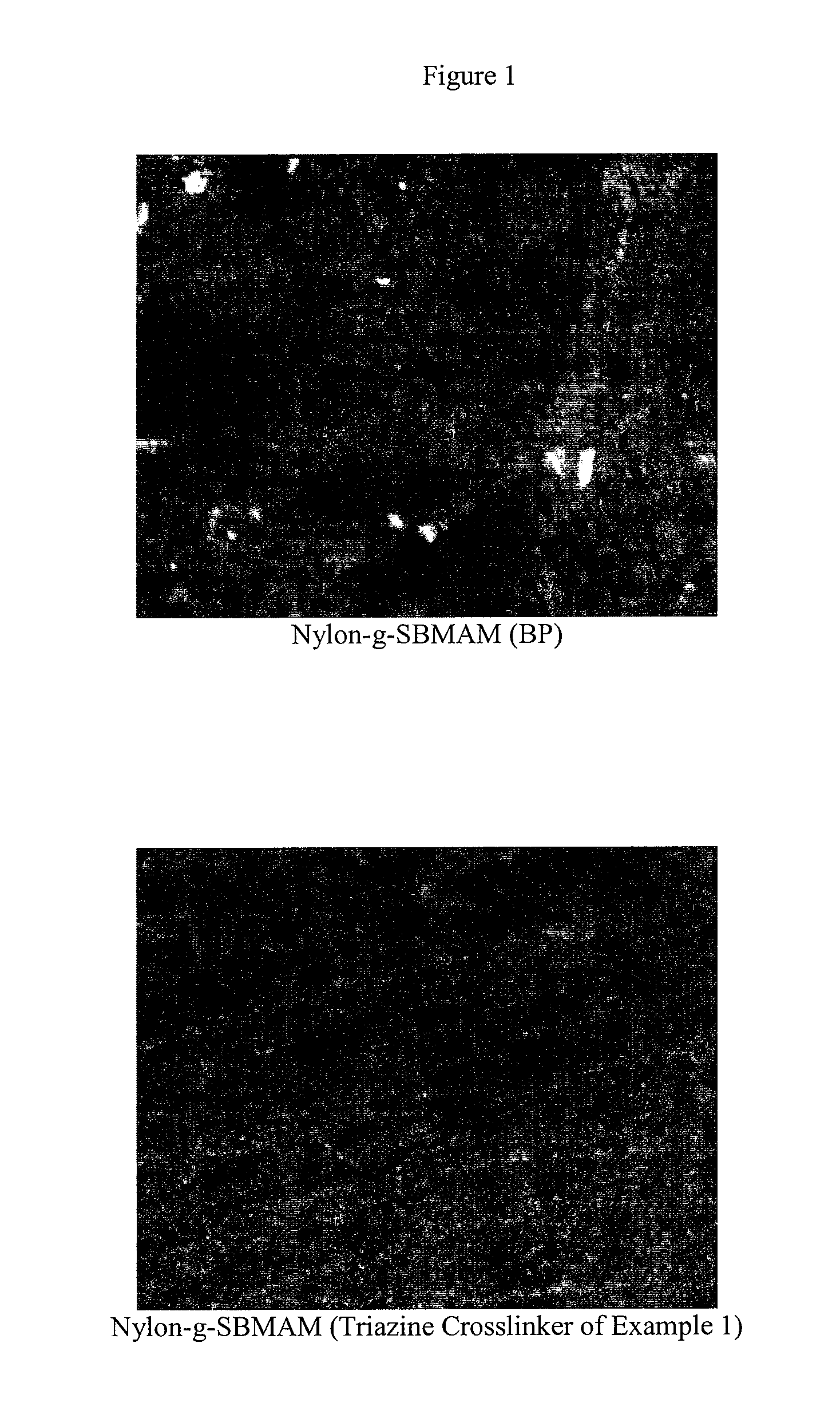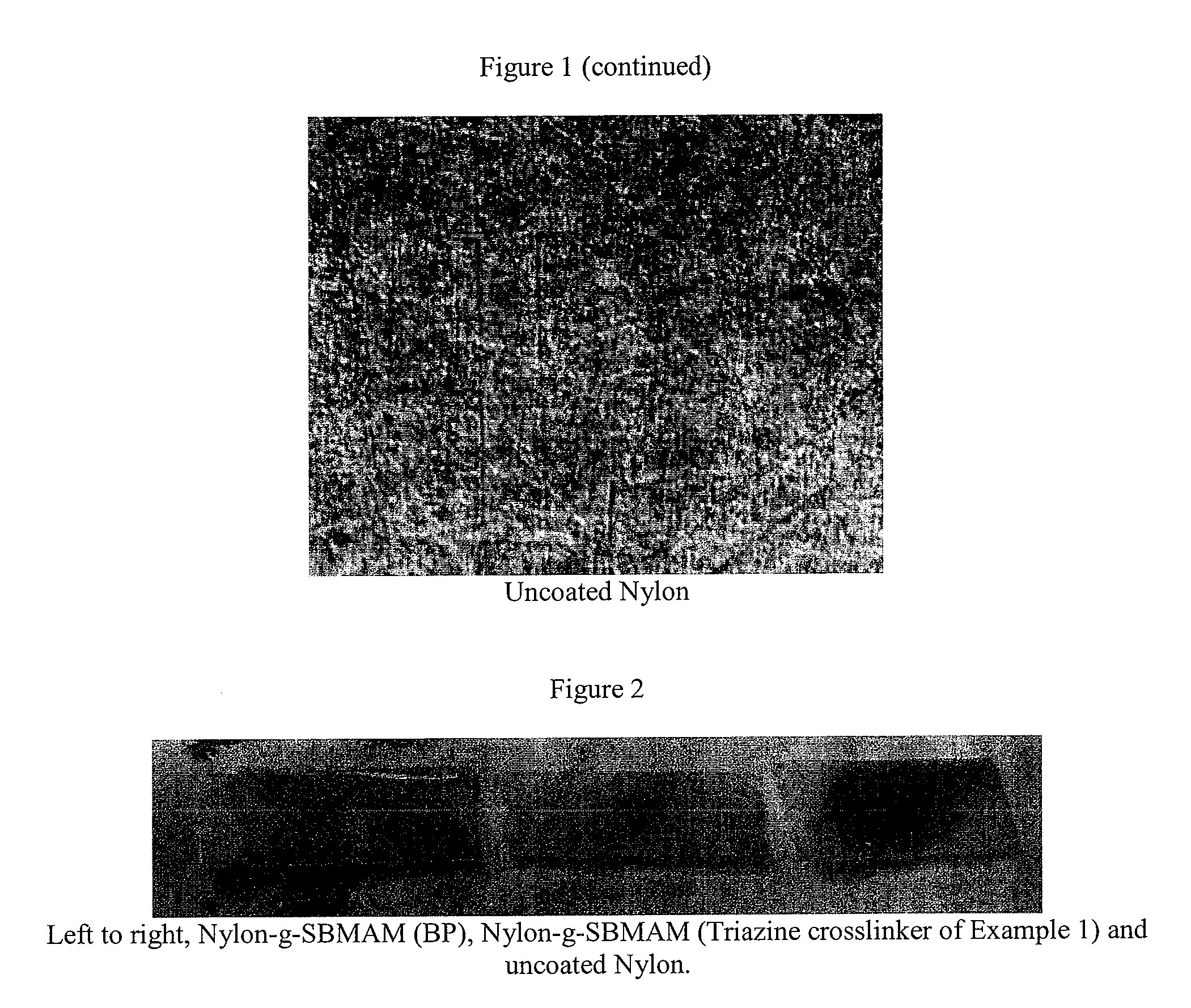Brush polymer coating by in situ polymerization from photoreactive surface
a technology of photoreactive surface and polymerization, which is applied in the direction of coatings, prostheses, transportation and packaging, etc., can solve the problems of significant pain, disability, and increased quality of life, and achieve the effect of reducing bacterial adhesion
- Summary
- Abstract
- Description
- Claims
- Application Information
AI Technical Summary
Benefits of technology
Problems solved by technology
Method used
Image
Examples
example 1
Synthesis of Trifunctional Triazine Crosslinker
[0823]1.2 g (4 mmol) of triglycidyl isocyanurate (Aldrich Chemicals, Milwaukee, Wis.) and 2.4 g (12 mmol) of 4-hydroxybenzophenone (Aldrich Chemicals, Milwaukee, Wis.) were mixed in a 50-ml round bottom flask containing a magnetic stir bar. The flask was flushed with argon for 10 min and heated to 130° C. in an oil bath. Once the reaction mixture melted, 6 mg (0.02 mmol) of triphenylphosphine (Aldrich Chemicals, Milwaukee, Wis.) was added. The mixture was stirred for another 2 minutes under argon and cooled to room temperature. The reaction residue was dissolved in 30 ml chloroform, then washed with 4N NaOH (30 ml×3) and deionized water (30 ml×3). The organic layer was dried over magnesium sulfate and concentrated to dryness on the under reduced pressure. The product was purified by column chromatography (silica gel, 230-400 mesh, Whatman, Inc.) using ethyl acetate as eluent (Rf˜4.5). The fractions containing the pure product were combi...
example 2
Synthesis of Photoreactive Glycol Crosslinker
[0825]2.26 g 4-hydroxybenzophenone (Aldrich Chemicals, Milwaukee, Wis.) was dissolved in 50 ml of acetone, and 0.532 ml of glycerol triglycidyl ether (Polysciences, Warrington, Pa.), and 3.3 g potassium carbonate (Aldrich Chemicals, Milwaukee, Wis.) were added to the solution. The reaction mixture was heated to reflux over 24 hours. After 24 hours of heating, thin layer chromatography (TLC) showed consumption of the glycerol starting material (eluent 20:1 Chloroform:methanol) and the emergence of three uv active spots. The acetone was removed by rotary evaporation and the residue was dissolved in chloroform, and filtered. The resulting chloroform solution was washed three times with 4N NaOH aqueous solution, once with deionized water, then twice with 1N HCl aqueous solution, and three times again with deionized water. The chloroform solution was dried over magnesium sulfate, filtered, and the solvent removed by rotary evaporation. The res...
example 3
Diethylene Glycol Photocrosslinker Synthesis
[0826]4-Hydroxybenzophenone, 2.2758 g (11.4811 mMol, 2 mol eq, Alfa Aesar, Ward Hill, Mass.), was added to a 100 mL round bottom flask equipped with a reflux condenser and dissolved in 75 mL of acetone. Ethylene glycol diglycidyl ether, 1.0000 g (5.7405 mMol, 1 mol eq Aldrich Chemicals, Milwaukee, Wis.) followed by potassium carbonate, 3.1736 g (22.9621 mMol, 4 mol eq), was then added to the mixture and was heated at reflux overnight. After cooling, the remaining solid was filtered and organic layer was removed in vacuo. The crude product mixture was redissolved in 60 mL of chloroform and the residual 4-Hydroxybenzophenone was removed by washing with a 4N NaOH aqueous solution. The organic layer was then dried over MgSO4 and filtered to remove drying agent. A portion of the chloroform solvent was removed in vacuo until 5 mL remained. The product was isolated by silica column (EMD Silica Gel 0.040-0.063 mm, 230-400 mesh, 60 Å) using (9:1) E...
PUM
| Property | Measurement | Unit |
|---|---|---|
| excitation wavelengths | aaaaa | aaaaa |
| composition | aaaaa | aaaaa |
| structure | aaaaa | aaaaa |
Abstract
Description
Claims
Application Information
 Login to View More
Login to View More - R&D
- Intellectual Property
- Life Sciences
- Materials
- Tech Scout
- Unparalleled Data Quality
- Higher Quality Content
- 60% Fewer Hallucinations
Browse by: Latest US Patents, China's latest patents, Technical Efficacy Thesaurus, Application Domain, Technology Topic, Popular Technical Reports.
© 2025 PatSnap. All rights reserved.Legal|Privacy policy|Modern Slavery Act Transparency Statement|Sitemap|About US| Contact US: help@patsnap.com



